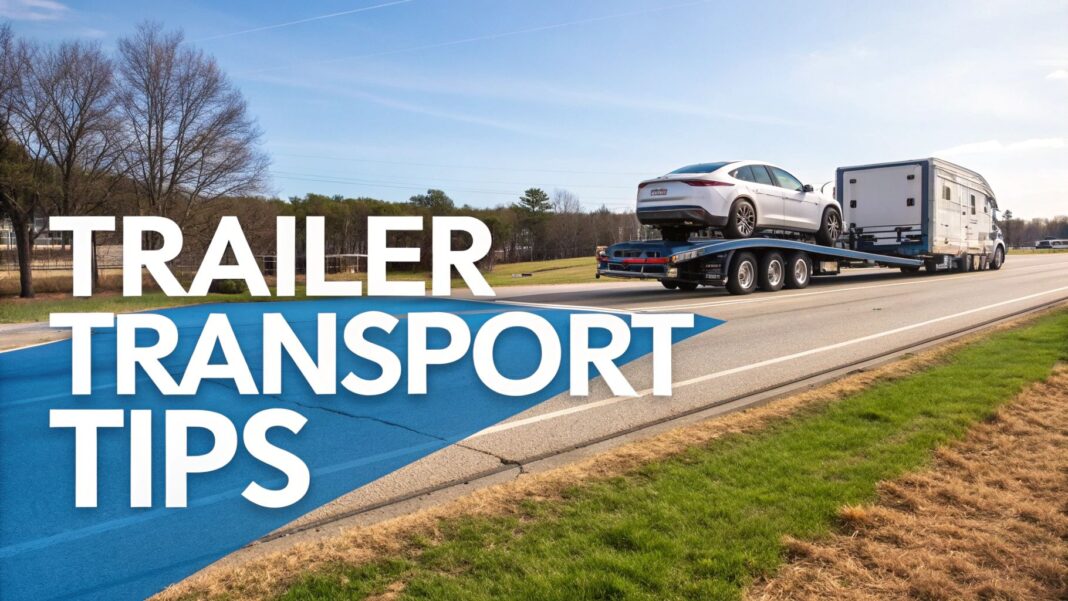
The success of your travel trailer transport hinges on preparation. Before the driver arrives, your primary task is to thoroughly prep your trailer. This single step is the most effective way to prevent damage, avoid unexpected costs, and ensure a smooth process. The goal is to methodically secure everything, both inside and out, transforming your trailer from a home back into a road-ready vehicle.
Your Pre-Transport Preparation Guide

Highway transport subjects your trailer to constant vibrations, bumps, and jarring movements that can wreak havoc on unsecured items. Investing time in preparation protects your asset and prevents the hassle of insurance claims. This process is divided into two key areas: securing the interior and preparing the exterior systems for transit.
Securing Your Trailer's Interior
Think of transport as a continuous, low-grade earthquake. Anything not secured is a potential projectile. Your first action should be to remove all loose items. This includes decorations, kitchenware, personal belongings, and any valuables.
Next, focus on cabinets and drawers. Factory latches are often insufficient for road travel. Use zip ties or bungee cords to ensure cabinet doors and drawers remain shut. For fragile items like dishes, use non-slip liners and pack them tightly with towels or foam to eliminate movement and prevent breakage. Securely latch all interior doors, including those for bathrooms and bedrooms.
A critical step is securing large appliances. Tape the refrigerator door shut. Remove any loose components, such as the glass turntable in the microwave, and store them securely.
Preparing the Exterior for the Road
Proper exterior preparation is vital for a safe and efficient pickup. While the driver will conduct a professional inspection, having your trailer ready demonstrates diligence and accelerates the handover process.
Conduct a thorough walk-around inspection using this checklist:
- Secure All Compartments: Confirm that every exterior storage bay, access panel, and service door is latched securely. For any loose-fitting latches, apply sturdy tape for added security.
- Disconnect Utilities: This is a mandatory safety requirement. Disconnect and physically remove all propane tanks. Completely drain the fresh water, grey water, and black water tanks. Disconnect the trailer from any external power sources.
- Inspect Tires and Lights: Inflate all tires to the manufacturer's recommended pressure. While the transport company is responsible for their vehicle, your trailer's tires must be roadworthy. Test all running lights, brake lights, and turn signals to ensure they are fully operational.
Finally, create a detailed visual record. Before pickup, take numerous time-stamped photos and videos of your trailer from every angle, inside and out. This documentation serves as indisputable proof of your trailer's pre-transport condition, which is invaluable in the event of a damage claim.
For a more exhaustive checklist, review this guide on preparing a trailer for tow and go transport to ensure every detail is covered. This simple action provides ultimate peace of mind.
Choosing the Right Transport Company
Selecting the right company for your travel trailer transport is the most critical decision you'll make. This isn't merely about finding the lowest price; it's about entrusting your valuable asset to a professional. You must evaluate a company's reliability, credentials, and service offerings to find the right fit for your specific needs.
The first step is to determine the correct service type: tow-away or flatbed transport. Making the right choice from the outset will prevent significant complications later.
Tow-Away Versus Flatbed Services
A tow-away service is the most common method. A professional driver hitches your travel trailer to a heavy-duty truck and tows it to the destination. This is the most cost-effective solution for trailers that are roadworthy, meaning they have safe tires, functional brakes, and operational lights.
Flatbed transport, in contrast, involves loading your entire trailer onto a large flatbed truck. This service is necessary if your trailer is not road-ready due to issues like damaged tires, expired registration, or if it's a non-operational project vehicle. While more expensive due to the required specialized equipment, it is the only safe and legal method for moving a non-roadworthy trailer.
Regardless of the service type, thorough company vetting is essential. The rising popularity of RVing has led to an influx of new transporters, and their quality varies significantly.
Reputable transport companies operate with full transparency. They should readily provide their DOT number, proof of cargo insurance, and a detailed contract. Any hesitation to produce these fundamental documents is a major red flag, and you should immediately move on.
Vetting a Company Like a Pro
Your objective is to confirm that a carrier is legally authorized, properly insured, and experienced.
First, request their U.S. Department of Transportation (DOT) and Motor Carrier (MC) numbers. Use these numbers to verify their status on the Federal Motor Carrier Safety Administration (FMCSA) website. Confirm their authority is "Active" and check their safety record.
Next, you must verify their insurance coverage. Specifically, ask for proof of cargo insurance, which covers your trailer against damage during transit. Do not just accept a policy number; request a copy of the insurance certificate. Call the listed insurance provider to confirm the policy is active and that the coverage amount is sufficient for the full value of your trailer.
Before committing, use this table to systematically compare potential carriers.
Comparing Transport Company Credentials
| Credential | What to Look For | Why It Matters |
|---|---|---|
| DOT & MC Numbers | Active status on the FMCSA website, satisfactory safety rating. | Confirms the company is legally authorized to operate as a commercial carrier across state lines. |
| Cargo Insurance | An active policy with coverage equal to or greater than your trailer's value. | This is what pays for repairs or replacement if your trailer is damaged during transport. |
| Written Contract | Clear terms for pickup/delivery, payment, and a defined process for damage claims. | The bill of lading is your legal agreement. Vague terms leave you unprotected. |
| Positive Reviews | Consistent feedback on multiple platforms about communication and professionalism. | Shows a track record of reliability and good customer service from people who've used them. |
Using this checklist for every company you consider is the most effective way to distinguish professional carriers from unqualified operators.

The image above illustrates the complex weight calculations professional drivers manage. Ensuring the combined vehicle weight is within legal and safe limits is crucial for preventing mechanical failures and ensuring a safe journey—a task that should never be left to an amateur.
The global travel trailer market is projected to grow from USD 15.1 billion in 2025 to USD 21.3 billion by 2035. This rapid expansion underscores the increasing need for qualified, expert transporters to handle these valuable assets.
Finally, read the entire contract or bill of lading before signing. Confirm that pickup and delivery windows are clearly defined, the payment schedule is understood, and the process for handling potential damage is explicitly outlined. A reputable company will provide all of this in a clear, written agreement.
For more insights into identifying top-tier carriers, consult our guide on selecting professional RV movers.
Understanding Transport Costs and Quotes

When gathering quotes for travel trailer transport, you'll find that prices vary significantly. There is no standard rate, as the final cost is a complex calculation of logistics, labor, and risk. Understanding the factors that influence the price is essential for accurate budgeting and identifying a fair quote.
Distance is the most significant cost driver, but the route is just as important. A cross-country journey through mountainous terrain or congested urban areas will cost more than a straightforward trip on flat highways due to increased fuel consumption and time.
Key Factors That Shape Your Quote
To receive an accurate and binding quote, you must provide specific details about your trailer. Vague information will only yield a rough estimate that is likely to change.
- Trailer Dimensions and Weight: This is a primary factor. Larger and heavier trailers require more powerful trucks and consume more fuel. You must provide the exact length, width, height, and the Gross Vehicle Weight Rating (GVWR).
- Transport Method: A standard tow-away service for a roadworthy trailer is the most economical option. If your trailer requires flatbed transport, expect a substantial price increase due to the need for specialized equipment and additional labor.
- Seasonality and Demand: The transport industry experiences peak seasons. Moving a trailer during summer or around major holidays often costs more due to higher demand. Booking during the off-season, such as late fall or winter, can lead to significant savings.
For a broader perspective on industry pricing, a moving company cost comparison guide can help you benchmark the quotes you receive.
Demystifying Insurance and Extra Fees
A professional quote will include carrier insurance, but it is your responsibility to verify the details. This cargo insurance policy protects your trailer while it is under the carrier's care. Always request a copy of their insurance certificate and confirm that the coverage amount is sufficient to cover the full value of your trailer.
Do not assume the standard policy is adequate. Ask specifically about the deductible amount and the claims process. For new or high-value trailers, purchasing supplemental insurance can provide valuable peace of mind.
Finally, be aware of potential ancillary fees. These can include storage charges for delayed pickup, detour fees, or additional labor costs for difficult delivery locations. A transparent carrier will clearly itemize all potential charges in the contract.
Knowing what you're paying for is the best way to compare quotes and choose a service that gives you real value for your money.
Managing the Pickup and Delivery
The pickup and delivery are the two most critical events in the transport process. Effective communication and careful execution on these days are essential for a successful outcome.
Before the driver arrives, prepare the pickup location. Ensure there is ample space for a large truck to maneuver. Clear your driveway, move other vehicles, and provide an unobstructed path. Have your keys, registration documents, and any necessary permits ready.
The most important document you will handle is the Bill of Lading (BOL). This serves as both your legal contract and the official condition report. Do not allow the driver to rush you through this process.
The Pickup: Your Pre-Trip Inspection
The pre-trip inspection is a collaborative effort between you and the driver. Together, conduct a detailed walk-around of the trailer. Point out any existing scratches, dings, or signs of wear.
Your objective is to ensure every pre-existing imperfection is noted on the BOL. Use the photos and videos you took earlier as a reference. Once both parties agree on the trailer's initial condition, you will sign the BOL. This signature officially documents the "before" state of your trailer, which is your primary evidence if a damage claim becomes necessary.
While your trailer is in transit, reasonable communication is expected. Most drivers provide updates at the end of the day or if there are significant delays. A daily text message to check on progress is acceptable.
The Delivery: Final Walk-Through
Upon arrival at the destination, you will repeat the inspection process in reverse. This final walk-through is equally important.
Before signing any final paperwork, take your copy of the BOL and perform a thorough inspection with the driver. Compare the trailer's current state to the notes and photos from the pickup.
- Check the exterior for any new scratches, dents, or scuffs.
- Inspect the tires, awnings, and other external components.
- Look inside for any signs of shifting or damage to fixtures.
If you discover any new damage, you must document it on the BOL before the driver leaves. Take clear photographs of the damage from multiple angles. This is your only opportunity to formally record transit-related issues; this documentation is non-negotiable for a successful insurance claim.
The moment you sign the final delivery form without noting damage, you are legally accepting the trailer in its delivered condition. Attempting to file a claim after this point is extremely difficult and rarely successful.
With the global travel trailer market projected to be worth USD 53.95 billion by 2025, as shown in this comprehensive travel trailer market analysis, these vehicles represent significant investments. Taking these logistical steps seriously is the best way to protect your asset.
Your Post-Transport Inspection Checklist

After your travel trailer arrives, resist the urge to quickly sign the paperwork. This final inspection is just as crucial as the pre-trip inspection. It is your last chance to identify and formally document any damage that occurred during transit.
Even with the best carrier, road travel involves vibrations and movements that can cause issues not immediately apparent. Use your copy of the Bill of Lading (BOL) from pickup as a guide to systematically compare the trailer's condition before and after its journey.
Inspecting for Transit Stress
Begin with a slow, detailed walk-around of the exterior, looking for any new scuffs or scratches not listed on the original BOL. Pay close attention to corners and the roofline, as these are common areas for minor contact.
Next, inspect the components most affected by a long haul.
- Tires and Axles: Check tire pressure immediately. Visually inspect the leaf springs and axles for any signs of shifting, fresh scrapes, or damage.
- Seals and Seams: Carefully examine the sealant around all windows, doors, and roof vents. The stress of transit can cause old or brittle seals to crack, creating potential water leaks.
- Frame and Hitch: Inspect the A-frame and hitch assembly. Look for any new stress cracks in the metal or damage to welds.
Crucial Tip: If you discover any new damage, however minor, document it immediately. Take clear, well-lit photos and make detailed notes directly on the delivery paperwork before you sign. This creates the official record required to initiate an insurance claim.
Getting Back to Adventure Ready
After completing the inspection and signing the paperwork, you can begin recommissioning your trailer. Follow these steps to ensure it is safe and operational.
Reconnect your propane tanks, ensuring the connections are tight and leak-free. Then, connect to shore power and your water supply. If the trailer was winterized for transport, you must now de-winterize it by flushing all antifreeze from the water system according to the manufacturer's instructions.
The Class A trailer type RV market grew from USD 1.48 billion in 2021 and is projected to reach USD 1.88 billion by 2025. This data, available on Cognitive Market Research, highlights the growing value of these investments and the importance of post-transport care.
Finally, conduct a full systems check. Test all lights, the water heater, air conditioning, and refrigerator. This final verification transitions your trailer from cargo back to your functional home-on-wheels.
Your Top Questions About Shipping a Travel Trailer Answered
Even with careful planning, questions often arise during the travel trailer transport process. Addressing these common concerns beforehand can prevent last-minute stress and surprises.
A frequent question is, "What happens if there's a mechanical issue during transport?" This is a valid concern. If the trailer has a flat tire or another mechanical problem, a professional transport company is equipped to handle it. Roadside assistance is part of their service, and they have procedures to manage such events at no additional cost to you.
Can I Pack My Stuff Inside the Trailer?
While it may seem efficient to use your trailer for moving personal belongings, the answer is almost always a definitive no.
Transporting personal items inside the trailer creates significant problems. First, the carrier's cargo insurance covers the trailer itself, not its contents. If your items are damaged or lost, you will likely have no recourse. Second, the added weight can alter the transport quote and potentially create safety hazards by unbalancing the load.
The professional standard is clear: If an item was not factory-installed, it should be removed before transport. This protects your belongings and prevents liability disputes.
How Does Shipping Insurance Actually Work?
By federal law, commercial carriers must maintain both liability and cargo insurance. The cargo policy is what protects your trailer from damage caused by driver negligence during transit.
Before signing a contract, demand a copy of their Certificate of Insurance. This document verifies that their coverage is active. Check the policy limit to ensure it meets or exceeds the value of your trailer. If the coverage is insufficient, you should purchase a supplemental insurance policy to be fully protected.
Another common inquiry is about transporting pets. For safety and legal reasons, you cannot ship live animals inside a travel trailer. The interior is not climate-controlled during transit and poses a serious danger to any animal. You must arrange for separate, safe transport for your pets.
When you're ready for a transport experience where all these details are handled for you, the team at We Will Transport It is here to help. Get your free, no-obligation quote today and let us take care of the rest.







